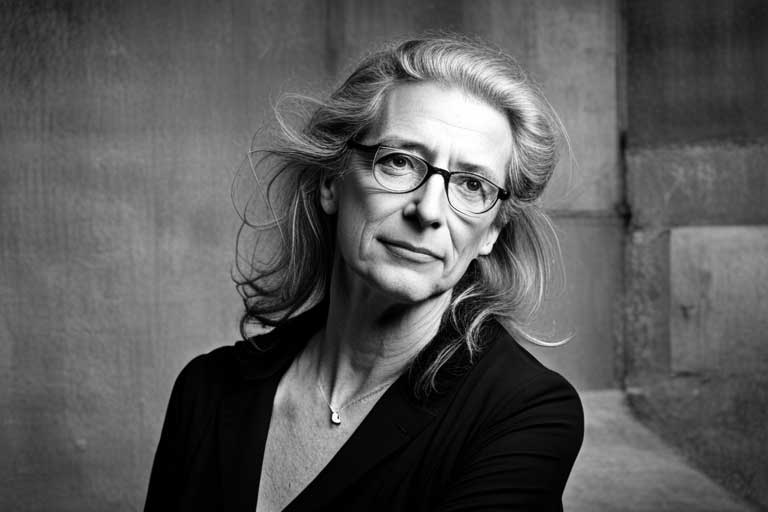Annie Leibovitz, a trailblazing American photographer, has been capturing the essence of her subjects for over five decades. With a creative approach and engaging style, Leibovitz has become one of the most celebrated photographers of our time. This article will dive deep into her life, career, and the techniques that have made her work stand out in the world of photography.
Early Life and Education
Born in 1949 in South Dakota, Annie Leibovitz was raised in a family that frequently moved due to her father’s career in the US Air Force. Her mother was a contemporary dance instructor, and the family’s travels exposed young Leibovitz to various cultures and artistic expressions. These experiences sparked her interest in the arts, leading her to pursue painting and music during her time at Roosevelt High School.
Leibovitz’s journey into photography began in earnest while studying painting at the San Francisco Art Institute. It was there that she discovered the works of legendary photographers such as Henri Cartier-Bresson and Robert Frank, who became significant influences on her creative direction. In addition to her painting studies, she took night classes in photography and honed her skills over time.
Career Beginnings: Rolling Stone Magazine
In 1970, Leibovitz got her first big break when she joined the newly established Rolling Stone publication as a staff photographer. Just three years later, she was promoted to chief photographer, becoming the first woman to hold that position. Her tenure at Rolling Stone played a crucial role in shaping her career, as she not only photographed countless celebrities but also found inspiration in the work of renowned photographer Richard Avedon.
Transition to Vanity Fair and Evolution of Style
Leibovitz’s exceptional talent did not go unnoticed, and in the 1980s, she was recruited by Vanity Fair magazine. It was here that she truly began to develop her signature style, characterized by vivid colors, dramatic lighting, and staged compositions. This new approach to celebrity portraiture quickly gained recognition and earned her the prestigious Clio Award in 1987 for her work on an American Express campaign.
A Photographer’s Life: Notable Projects and Exhibitions
Throughout her illustrious career, Leibovitz has been involved in numerous high-profile projects and exhibitions. Some of her most notable works include:
Disney Dream Portraits (2011)
In this enchanting series, Leibovitz captured celebrities as iconic Disney characters, showcasing her ability to create playful and imaginative scenes that resonate with audiences.
John Lennon and Yoko Ono (1980)
This powerful portrait, taken mere hours before Lennon’s tragic death, immortalizes the couple’s intimate relationship and has become one of the most iconic images in the history of photography.
https://www.npg.org.uk/collections/search/portrait/mw09608/Yoko-Ono-John-Lennon
National Portrait Gallery Exhibition (1991)
In 1991, Leibovitz became the first woman to have a solo exhibition at the National Portrait Gallery in Washington, D.C. The honor solidified her status as a groundbreaking artist, and her work continues to inspire generations of photographers.
https://www.npg.org.uk/collections/search/person/mp08186/annie-leibovitz?role=art
Annie Leibovitz: A Photographer’s Life (2006-2007)
This retrospective exhibition at the Brooklyn Museum showcased a diverse collection of Leibovitz’s work, ranging from celebrity portraits to deeply personal images of her family and partner, Susan Sontag.
Controversial Works: Miley Cyrus and LeBron James
Leibovitz has never shied away from pushing boundaries, and her work has occasionally sparked controversy. In 2008, she photographed a 15-year-old Miley Cyrus in a suggestive pose for Vanity Fair, which led to public outcry and apologies from both the photographer and the young star.
In another instance, Leibovitz’s 2008 Vogue cover featuring LeBron James and Gisele Bundchen drew criticism for its potential racial undertones. However, the photographer has remained largely silent on this matter, leaving room for interpretation and debate.
Legacy and Influence
Annie Leibovitz’s creative and engaging approach to photography has left an indelible mark on the industry. Her ability to capture the essence of her subjects, combined with her innovative techniques, has influenced countless photographers and solidified her place in the annals of art history.
Whether it’s an intimate portrait of a celebrity or a whimsical recreation of a Disney scene, Leibovitz’s work continues to captivate audiences with its unique blend of creativity and emotional depth. As her career continues to evolve, there’s no doubt that Annie Leibovitz will remain a beacon of inspiration for generations of artists to come.


